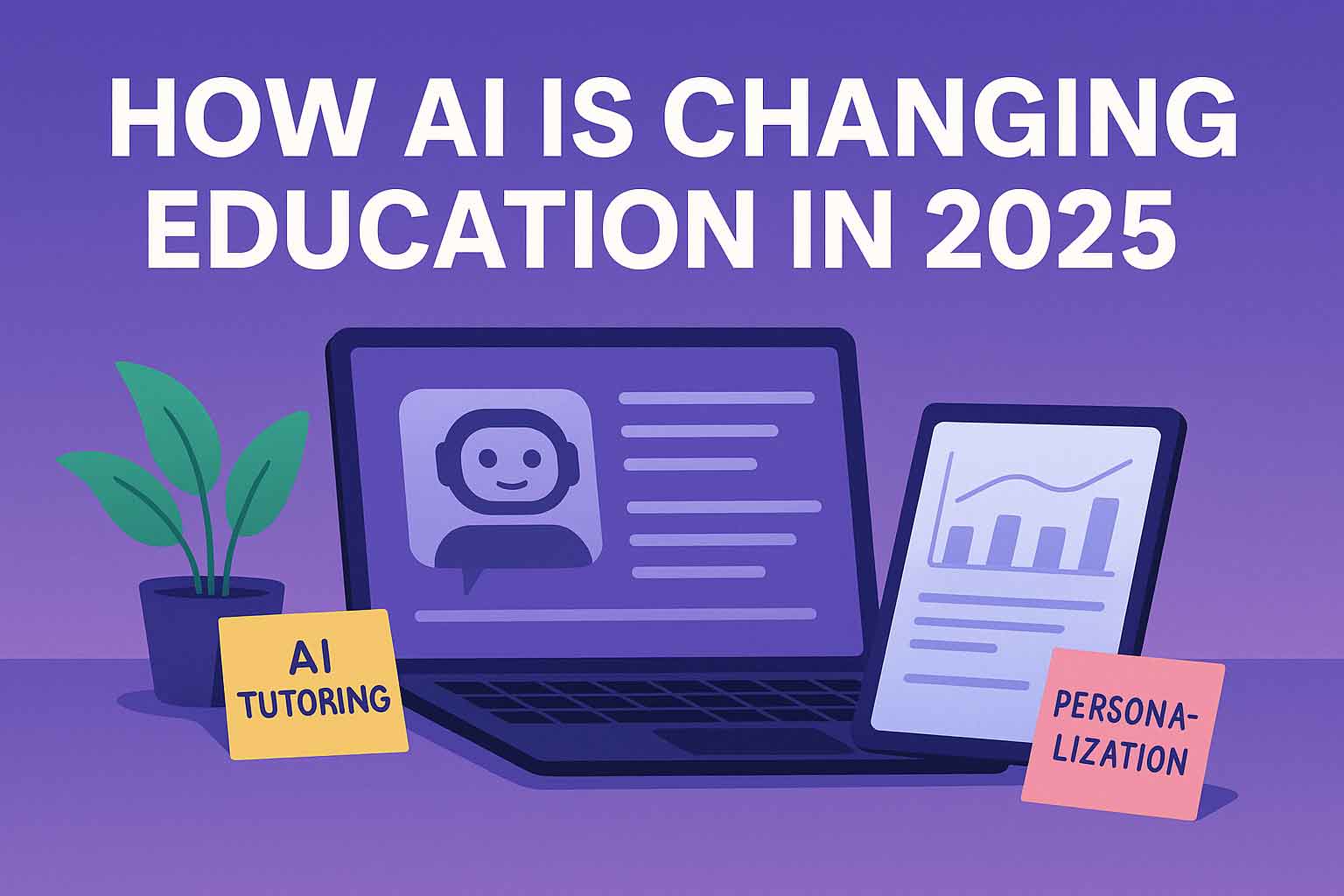The 2025 classroom looks very different (and better)
If you walk into a school, tutoring center, or college campus in 2025, you’ll notice something right away: AI is everywhere, but it’s working quietly in the background to make learning more personal, fair, and efficient. Teachers aren’t being replaced; they’re being augmented. Students aren’t cutting corners; they’re learning faster and more deeply with feedback that would’ve been impossible at scale even a few years ago.
In this guide, we’ll break down the biggest shifts you’ll see this year, from AI tutoring and adaptive learning to grading assistants, accessibility, and academic integrity, plus the best ways students and teachers can start using these tools the right way.
New here? You might also like:
• Best AI Tools for Students (2025)
• How to Use ChatGPT for Daily Tasks
• Canva AI Magic Tools: Full Tutorial
• Free vs Paid AI Tools: Which Should You Choose?
Personalized learning moves from buzzword to baseline
The biggest upgrade AI brings to education in 2025 is true personalization. Modern AI study apps and adaptive learning platforms now adjust difficulty in real time, recommend just-right practice, and surface explanations that match each learner’s style. For a student, that means less time stuck and more time in the “aha!” zone. For teachers, it means dashboards that show who needs help, where, and why—without hours of manual analysis.
How to try it today:
- Use a conversational tutor like ChatGPT to explain a concept three ways (simple, visual, analogy). Then ask for five practice questions that increase in difficulty. Start here: How to Use ChatGPT for Daily Tasks.
- Build visual notes and presentations with Canva’s Magic Write and Magic Design so learners get multimodal scaffolds (text + visuals). Tutorial: Canva AI Magic Tools.
AI tutors that actually teach (not just give answers)
Early “homework helpers” had a reputation for spitting out solutions. In 2025, the best AI tutoring experiences are Socratic: they ask guiding questions, nudge you through hints, and only reveal steps when you’re ready. The result is less answer-hunting and more real understanding.
Student tip: When you ask for help, add constraints like: “Don’t give the final answer; ask me questions until I get it.” You’ll struggle productively—just like working with a great teacher.
Teachers win back time with AI planning and grading assistants
Planning lessons, creating assessments, giving feedback, and drafting parent updates can devour evenings. AI teaching assistants now generate first drafts of lesson plans aligned to standards, write rubric-based comments, and compile personalized study plans after a quiz, so teachers can spend more time with students.
Smart workflow:
Draft with AI → personalize with your voice → share. You’ll move faster without losing your signature style. For writing support and polish, many educators pair drafting tools with Grammarly and then format visuals in Canva.
Accessibility: AI levels the playing field
One of the most meaningful shifts AI brings to education is better accessibility. Auto-captions and transcripts make lectures searchable. Text simplification helps English-language learners. Voice input and text-to-speech support students with dyslexia or visual impairments. And AI image tools turn complex diagrams into labeled, high-contrast versions for learners who need clarity.
If you’re presenting content, run it through an AI assistant and ask: “Make this accessible: captions, alt text, and a plain-language summary.” You’ll reach more students—instantly.
Academic integrity in the age of generative AI
Yes, AI can produce essays—and no, that doesn’t mean learning is over. Schools are responding with authentic assessments (oral defenses, project-based work, in-class writing) and transparent AI policies. The winning approach in 2025 isn’t banning AI; it’s teaching students how to use it responsibly: document prompts used, note what the AI generated, and reflect on the revisions you made.
If you publish classroom guidelines, add a simple AI use statement: “AI may be used for brainstorming, outlines, and language support. All final work must reflect your understanding. Cite any AI assistance.”
Safer, smarter research for essays and projects
Research has always been a time sink. AI now helps synthesize sources, compare viewpoints, and outline arguments—but the golden rule remains: verify facts and cite original sources. Use AI to speed up the “messy middle,” not to invent citations.
A practical flow: ask your assistant for a topic map → gather primary sources → request a balanced outline with counterarguments → draft → refine. If you’re choosing tools, see our breakdown: Free vs Paid AI Tools.
Creativity and multimodal projects are exploding
From podcasts and explainers to lab demos and history timelines, students are using AI video tools and AI image tools to tell richer stories. With Canva’s AI features, you can script, design, and export a polished presentation in a class period. With text-to-video tools, you can turn a lab report into a 60-second explainer and reach peers who learn better visually.
Starting points:
- Visuals & slides: Canva AI Magic Tools
- Study & planning: Best AI Tools for Students
Data privacy and ethics: the non-negotiables
Schools should choose tools that respect student privacy, allow data export/deletion, and provide clear logging of AI assistance. Teachers can model good practice by turning on transparency: show students how you used AI to draft a rubric or build a study guide, and explain what you changed and why. This builds AI literacy right alongside content knowledge.
Getting started: a simple 5-day plan
Day 1 – Personal study coach: Pick one course. Ask an AI to build a 7-day study plan with daily goals and quick quizzes.
Day 2 – Concept mastery: Take yesterday’s hardest concept and ask for three analogies plus a diagram description you can sketch.
Day 3 – Writing upgrade: Draft a paragraph; ask AI for clarity and evidence suggestions; revise and keep the changes you own.
Day 4 – Visualize it: Turn notes into slides or a one-page infographic with Canva’s Magic Write/Design.
Day 5 – Reflect: Journal how AI helped, what you learned faster, and what you’ll do differently next week.
Want more structure? Pair this with our student starter kit: Best AI Tools for Students.
For deeper comparisons and buyer intent visitors, route readers to:
The bottom line
AI isn’t replacing teachers or real learning, it’s giving both a boost. In 2025, the schools and students who thrive are the ones who treat AI like a coach, not a shortcut. Use it to tailor practice, visualize tough ideas, get timely feedback, and free up time for the human parts of education: discussion, curiosity, and creation.
If you’re a student, start with one workflow this week, a smarter study plan, clearer notes, or a more visual project. If you’re an educator, pilot AI for planning or feedback and invite students into the process with transparent guidelines.
What change are you most excited about, AI tutoring, grading assistants, or accessible, multimodal learning? Tell us in the comments, and share this post with a teacher or classmate who’s curious about AI in education.




